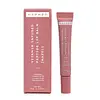What's inside
What's inside
 Key Ingredients
Key Ingredients

 Benefits
Benefits

 Concerns
Concerns

 Ingredients Side-by-side
Ingredients Side-by-side

Hydrogenated Polyisobutene
EmollientHelianthus Annuus Flower
Skin ConditioningOlive Oil PEG-7 Esters
EmollientSynthetic Wax
AbrasiveCaprylic/Capric Triglyceride
MaskingPropylene Glycol
HumectantParaffin
PerfumingSqualane
EmollientPolyurethane-79
Glycol Montanate
EmulsifyingTocotrienols
Skin ConditioningLinoleic Acid
CleansingTripeptide-1
Skin ConditioningHexapeptide-9
Skin ConditioningPalmitoyl Tripeptide-5
Skin ConditioningPalmitoyl Pentapeptide-4
Skin ConditioningPalmitoyl Tetrapeptide-7
Skin ConditioningButyrospermum Parkii Butter
Skin ConditioningTapioca Starch
Vanillin
MaskingCaprylyl Glycol
EmollientSucralose
Skin ConditioningGlycerin
HumectantWater
Skin ConditioningPolysorbate 20
EmulsifyingCI 77891
Cosmetic ColorantCI 77499
Cosmetic ColorantCI 77492
Cosmetic ColorantCI 45410
Cosmetic ColorantCI 45380
Cosmetic ColorantHydrogenated Polyisobutene, Helianthus Annuus Flower, Olive Oil PEG-7 Esters, Synthetic Wax, Caprylic/Capric Triglyceride, Propylene Glycol, Paraffin, Squalane, Polyurethane-79, Glycol Montanate, Tocotrienols, Linoleic Acid, Tripeptide-1, Hexapeptide-9, Palmitoyl Tripeptide-5, Palmitoyl Pentapeptide-4, Palmitoyl Tetrapeptide-7, Butyrospermum Parkii Butter, Tapioca Starch, Vanillin, Caprylyl Glycol, Sucralose, Glycerin, Water, Polysorbate 20, CI 77891, CI 77499, CI 77492, CI 45410, CI 45380
Ricinus Communis Seed Oil
MaskingCaprylic/Capric Triglyceride
MaskingIsopropyl Myristate
EmollientCandelilla Cera
EmollientCopernicia Cerifera Wax
Helianthus Annuus Seed Oil
EmollientButyl Methoxydibenzoylmethane
UV AbsorberCera Microcristallina
Emulsion StabilisingTheobroma Cacao Seed Butter
EmollientAstrocaryum Murumuru Seed Butter
EmollientEthylhexyl Salicylate
UV AbsorberHomosalate
Skin ConditioningOctocrylene
UV AbsorberHydrogenated Castor Oil
EmollientOzokerite
Emulsion StabilisingMangifera Indica Seed Butter
Skin ConditioningGarcinia Indica Seed Butter
Skin ConditioningPrunus Amygdalus Dulcis Oil
Skin ConditioningTheobroma Grandiflorum Seed Butter
Skin ConditioningTocopherol
AntioxidantSodium Hyaluronate
HumectantSoybean Glycerides
EmollientButyrospermum Parkii Butter Unsaponifiables
Skin ConditioningVanilla Planifolia Fruit Oil
EmollientPhytosteryl/Octyldodecyl Lauroyl Glutamate
Skin ConditioningLinoleic Acid
CleansingLinolenic Acid
CleansingRicinus Communis Seed Oil, Caprylic/Capric Triglyceride, Isopropyl Myristate, Candelilla Cera, Copernicia Cerifera Wax, Helianthus Annuus Seed Oil, Butyl Methoxydibenzoylmethane, Cera Microcristallina, Theobroma Cacao Seed Butter, Astrocaryum Murumuru Seed Butter, Ethylhexyl Salicylate, Homosalate, Octocrylene, Hydrogenated Castor Oil, Ozokerite, Mangifera Indica Seed Butter, Garcinia Indica Seed Butter, Prunus Amygdalus Dulcis Oil, Theobroma Grandiflorum Seed Butter, Tocopherol, Sodium Hyaluronate, Soybean Glycerides, Butyrospermum Parkii Butter Unsaponifiables, Vanilla Planifolia Fruit Oil, Phytosteryl/Octyldodecyl Lauroyl Glutamate, Linoleic Acid, Linolenic Acid
Alternatives
Ingredients Explained
These ingredients are found in both products.
Ingredients higher up in an ingredient list are typically present in a larger amount.
This ingredient is an emollient, solvent, and texture enhancer. It is considered a skin-softener by helping the skin prevent moisture loss.
It helps thicken a product's formula and makes it easier to spread by dissolving clumping compounds.
Caprylic Triglyceride is made by combining glycerin with coconut oil, forming a clear liquid.
While there is an assumption Caprylic Triglyceride can clog pores due to it being derived from coconut oil, there is no research supporting this.
Learn more about Caprylic/Capric TriglycerideLinoleic Acid is also known as Vitamin F. It is a fatty acid with emollient and skin conditioning properties. Our top layer of skin, or epidermis, contains high amounts of linoleic acid naturally.
Your body uses linoleic acid to build ceramides and prostaglandins. Ceramides keep your skin's barrier hydrated and strong while prosaglandins help control inflammation and healing. Needless to say, linoleic acid is crucial for having a strong skin barrier.
One study found applying linoleic acid rich sunflower oil to be more effective at repairing the skin barrier than oleic rich olive oil.
Linoleic acid is an essential fatty acid, meaning our bodies cannot create it on its own. We need to get linoleic acid through foods such as nuts and vegetable oils.
Acne-prone skin tends to have linoleic acid and high levels of oleic acid.
Linoleic acid can also help treat acne by softening sebum to prevent clogged pores. Another study found using 2.5% linoleic acid gel for 4 weeks showed a 25% reduction in small comedones.
This ingredient can also help lighten hyperpigmentation or sun spots by disrupting the melanin production process. It also helps your skin shed melanin pigment from your skin caused by UV exposure.
Due to its role in the production of the fatty acid prostaglandin, linoleic acid can also help reduce inflammation and support wound healing.
Linoleic acid is not always fungal-acne safe; it may trigger flare-ups in sensitive individuals.
Learn more about Linoleic Acid